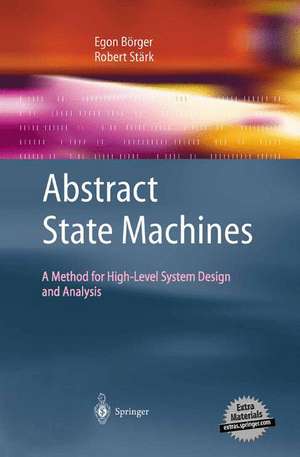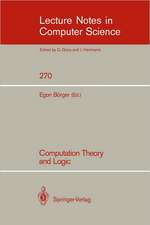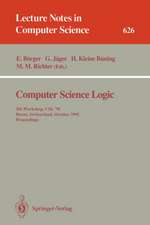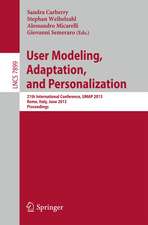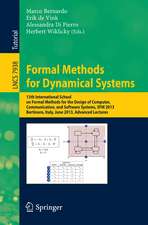Abstract State Machines: A Method for High-Level System Design and Analysis
Autor Egon Börger, Robert Stärken Limba Engleză Hardback – 23 apr 2003
| Toate formatele și edițiile | Preț | Express |
|---|---|---|
| Paperback (1) | 339.99 lei 43-57 zile | |
| Springer Berlin, Heidelberg – 3 oct 2013 | 339.99 lei 43-57 zile | |
| Hardback (1) | 346.10 lei 43-57 zile | |
| Springer Berlin, Heidelberg – 23 apr 2003 | 346.10 lei 43-57 zile |
Preț: 346.10 lei
Preț vechi: 432.62 lei
-20% Nou
Puncte Express: 519
Preț estimativ în valută:
66.23€ • 69.32$ • 55.12£
66.23€ • 69.32$ • 55.12£
Carte tipărită la comandă
Livrare economică 31 martie-14 aprilie
Preluare comenzi: 021 569.72.76
Specificații
ISBN-13: 9783540007029
ISBN-10: 3540007024
Pagini: 452
Ilustrații: X, 438 p. With online files/update.
Dimensiuni: 155 x 235 x 29 mm
Greutate: 0.79 kg
Ediția:2003
Editura: Springer Berlin, Heidelberg
Colecția Springer
Locul publicării:Berlin, Heidelberg, Germany
ISBN-10: 3540007024
Pagini: 452
Ilustrații: X, 438 p. With online files/update.
Dimensiuni: 155 x 235 x 29 mm
Greutate: 0.79 kg
Ediția:2003
Editura: Springer Berlin, Heidelberg
Colecția Springer
Locul publicării:Berlin, Heidelberg, Germany
Public țintă
Professional/practitionerCuprins
1 Introduction.- 1.1 Goals of the Book and Contours of its Method.- 1.2 Synopsis of the Book.- 2 ASM Design and Analysis Method.- 2.1 Principles of Hierarchical System Design.- 2.2 Working Definition.- 2.3 Explanation by Example: Correct Lift Control.- 2.4 Detailed Definition (Math. Foundation).- 2.5 Notational Conventions.- 3 Basic ASMs.- 3.1 Requirements Capture by Ground Models.- 3.2 Incremental Design by Refinements.- 3.3 Microprocessor Design Case Study.- 4 Structured ASMs (Composition Techniques).- 4.1 Turbo ASMs (seq, iterate, submachines, recursion).- 4.2 Abstract State Processes (Interleaving).- 5 Synchronous Multi-Agent ASMs.- 5.1 Robot Controller Case Study.- 5.2 Real-Time Controller (Railroad Crossing Case Study).- 6 Asynchronous Multi-Agent ASMs.- 6.1 Async ASMs: Definition and Network Examples.- 6.2 Embedded System Case Study.- 6.3 Time-Constrained Async ASMs.- 6.4 Async ASMs with Durative Actions.- 6.5 Event-Driven ASMs.- 7 Universal Design and Computation Model.- 7.1 Integrating Computation and Specification Models.- 7.2 Sequential ASM Thesis (A Proof from Postulates).- 8 Tool Support for ASMs.- 8.1 Verification of ASMs.- 8.2 Model Checking of ASMs.- 8.3 Execution of ASMs.- 9 History and Survey of ASM Research.- 9.1 The Idea of Sharpening Turing’s Thesis.- 9.2 Recognizing the Practical Relevance of ASMs.- 9.3 Testing the Practicability of ASMs.- 9.4 Making ASMs Fit for their Industrial Deployment.- 9.5 Conclusion and Outlook.- References.- List of Problems.- List of Figures.- List of Tables.
Recenzii
From the reviews:
"The Turing Test gives a comprehensive, in-depth and contemporary assessment of this classic topic in artificial intelligence. This book elaborates in detail the numerous conflicting points of view on many aspects of this multifaceted, controversial subject. … This volume is a valuable reading for research on the Turing test and for teaching undergraduate and graduate students in philosophy, computer science, and cognitive science." (Jörg Desel, Zentralblatt MATH, Vol. 1040 (9), 2004)
"Borger and Stark do an admirable job of documention and extending a method for bridging the considerable gap between theoretical system models, which often only allow for toy systems to be modeled and require proofs to be done only by hand, and real-life systems and practices." (Shrisha, Rao, Ceda Rapids, IA, Computing Reviews, February, 2004)
"The Turing Test gives a comprehensive, in-depth and contemporary assessment of this classic topic in artificial intelligence. This book elaborates in detail the numerous conflicting points of view on many aspects of this multifaceted, controversial subject. … This volume is a valuable reading for research on the Turing test and for teaching undergraduate and graduate students in philosophy, computer science, and cognitive science." (Jörg Desel, Zentralblatt MATH, Vol. 1040 (9), 2004)
"Borger and Stark do an admirable job of documention and extending a method for bridging the considerable gap between theoretical system models, which often only allow for toy systems to be modeled and require proofs to be done only by hand, and real-life systems and practices." (Shrisha, Rao, Ceda Rapids, IA, Computing Reviews, February, 2004)
Textul de pe ultima copertă
The systems engineering method proposed in this book, which is based on Abstract State Machines (ASMs), guides the development of software and embedded hardware-software systems seamlessly from requirements capture to actual implementation and documentation. The method bridges the gap between the human understanding and formulation of real-world problems and the deployment of their algorithmic solutions by code-executing machines. Within a single conceptual framework it covers design, verification by reasoning techniques, and validation by simulation and testing. ASMs improve current industrial practice by using accurate high-level modeling and by linking the descriptions at the successive stages of system development in an organic and efficiently maintainable chain of rigorous and coherent system models at stepwise-refined abstraction levels. In several industrial projects the ASM method has proven its superiority compared to the popular UML methodology when designing complex parallel or dynamic systems.
This book combines the features of a textbook and a handbook: the reader will find detailed explanations, proofs, and exercises as well as numerous examples and real-world case studies. Researchers will find here the most comprehensive description of ASMs available today and professionals will use it as a "modeling handbook for the working software engineer." As a textbook it supports self-study or it can form the basis of a lecture course. Even more information can be found on the related website maintained by the authors: http://www.di.unipi.it/AsmBook/
Caracteristici
Comprehensive overview about abstract state machines and their usage in software engineering Students will like the book because of detailed proofs, explanations, and exercises Professionals will like the book for its numerous real-world examples and case studies Includes supplementary material: sn.pub/extras
